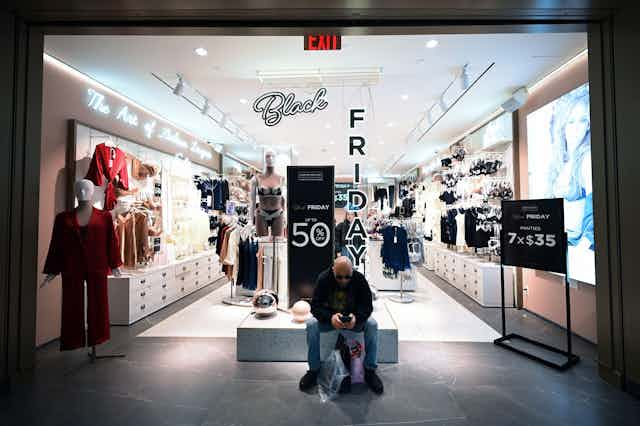When Americans are confident about their economy, they tend to support the incumbent president. When they are not confident, they tend to withdraw that support. The chart below shows that relationship between consumer confidence and public approval of incumbent US presidents’ performances over the last 45 years from January 1978 to December 2023, using monthly data.
The relationship between the two measures is not perfect, but when consumer confidence increased rapidly as it did under Republican Ronald Reagan in the 1980s and again under Democrat Bill Clinton in the 1990s, presidential approval ratings also increased rapidly at the same time.
In contrast, confidence reached a low point in 2008 after the financial crash, when Republican George W. Bush was in the White House. His approval ratings collapsed and this subsequently helped Democrat Barack Obama to be elected president when Bush stood down that year.
Graph showing presidential approval levels

That said, there is an anomaly in the chart – namely a breakdown in this relationship since Joe Biden was inaugurated as president in 2021. Consumer confidence fell quite rapidly prior to his presidency, largely because of the COVID pandemic. This continued after his inauguration, but from the spring of 2023 when the threat from COVID began to recede, confidence started to improve. However, Biden’s approval ratings did not follow suit and remained stalled at 41% (with 56% disapproving) by the end of the year.
What is the explanation for this? One possibility is that Americans are gloomy about the state of their nation at the present time. A Gallup poll published in December 2023 showed that 22% were satisfied and 77% dissatisfied with the state of the nation. Clearly Biden is experiencing the consequences of that downbeat mood. In addition, there are concerns about his age making it difficult to hold down such a demanding job.
However, this does not mean that Donald Trump necessarily has an advantage over the president if he wins the Republican nomination later this year. In December 2020, his last month in office, a mere 16% of Americans were satisfied with the state of the nation, compared with 83% who were dissatisfied . Furthermore, at age 77 he is nearly as old as the president, so there should be no political advantage in making age an issue in the election.
With a pretty poor public confidence record at the end of the time he was in office Trump cannot credibly claim to have done better than the current president. Unlike in 2016 when he was first elected, overall he had a rather dismal track record for gaining public confidence in office, despite his public bolster. Biden tweeted a quote from his father: “Don’t compare me to the Almighty. Compare me to the alternative.”
Another possible explanation for the anomaly between the US economic improvements and Biden’s approval ratings is that while the US economy is currently doing well, voters are not necessarily feeling it in their pockets yet.
Gross domestic product (GDP) in real terms (taking into account inflation) increased by a massive 4.9% in the third quarter of 2023, according to the US Bureau of Economic Analysis. But GDP indicators can feel vague and far removed from the reality of the ordinary person. There has been an upswing in economic indications so far in the run-up to the presidential election in November 2024, but no bump for Biden.
So does the well-used US political phrase “it’s the economy, stupid”, (used for decades to explain why people vote) not hold true for Biden? If the current president is to benefit from this economic performance, then consumer psychology needs to catch up with the booming economy. In addition, he has to rely on the voters not being put off by the general gloom about the state of the nation. What are the prospects of this happening?
Consumer confidence levels

The second chart, above, shows the relationship between consumer confidence and the misery index in the US over the same 45-year period. The misery index is the sum of the inflation and unemployment rates and so indicates how badly the economy is doing when it increases at any one point of time. The variables in the chart are measured in logarithmic scales (a way of showing data in a compact way). Expressing the measures in logarithms does not change the relationships between them, but it makes it easier to compare them visually.
The misery index has been used by academics to analyse the relationship between the state of the actual economy and voting and so provides an objective measure of economic performance. This can then be compared with the “subjective” measure of consumer confidence (how people feel).
There is a strong inverse or negative relationship between the two variables. For example, when the economy went into recession after the financial crash of 2008, the misery index rose rather rapidly and consumer confidence fell. Equally, when the COVID pandemic hit the economy in 2020 there was an instant cliff edge increase in the misery index, followed by a fall in consumer confidence. However, on that occasion the misery index abruptly changed while the consumer confidence index fell more slowly, with a lag in the response.
The implication of this relationship is that if the US economy continues to grow well into 2024, the consumer confidence index is likely to catch up and start to increase. If so, as the first chart shows, this will make it easier for Biden to win a second term.

